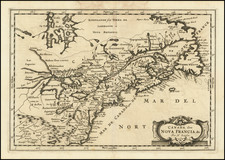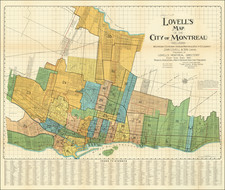Lahontan's Account of the Battle of Placentia
Nice example of Baron Lahontan's illustration of the Battle of Placentia (September 1692), which was fought between the English and the French at Fort St. Louis (Castle Hill) in Placentia, Newfoundland during King William's War.
The map is oriented with west at the top and shows the the positions of the warships involved, route of the vessels, and several important geographical details.
One of the most colorful and interesting individuals to visit Placentia in the seventeenth century was Baron Lahontan, who assisted in the defense of the settlement and, in so doing, prevented the English from capturing the town and, with it, control of the south coast fisheries. After a decade of travelling around Central Canada and the American Midwest. In 1692, the officer pitched his proposal for the defense of the western frontier of New France to Governor Frontenac. His efforts met with approval and Lahontan was sent to France to present the plan to the French Court.
En route on the Sainte-Anne, Lahontan put into Plaisance on August 18. He waited there to join a convoy to cross the Atlantic. While waiting, on September 14, 1692, news arrived that five English ships had been sighted nearby. The next day, the English arrived off Plaisance. Lahontan was included in the defense plans by Governor Brouillan, who sent him and sixty Basque fishermen to La Fontaine Cove to prevent an English landing.
On September 17, several hundred English attempted such a landing, but were kept back. On the 18th, Philippe Pastour de Costebelle and Lahontan were received aboard the English flagship to arrange an exchange of prisoners and unsuccessfully discuss terms of surrender. The French refused to surrender; the next day, the English ships arranged themselves in a line formation and began to bombard the fort. The French put up a strong resistance and, after five or six hours, the English vessels withdrew. The episode was a high point in Lahontan's military career; he is better remembered as a fanciful explorer.
The Baron Lahontan and his travels, real and imagined
Louis-Armand de Lom d’Arce, the third Baron Lahontan, was a member of the aristocracy. Born in 1666, he was forced into a career in the military by the family’s hardship after his father’s death. He served across the Atlantic, in New France.
Lahontan was dispatched as part of a force who were to defeat the Iroquois tribes near the Great Lakes. In addition to, or perhaps instead of, his military duties he explored much of the upper Mississippi River Valley. While serving at Boucherville, Lahontan learned Algonquin. Later, he commanded Fort St. Joseph, on the site of what is now Detroit.
While Lahontan certainly saw a great deal of the Great Lakes region, in 1688 he set out on his most fantastic journey. So fantastic, in fact, that it is unclear whether or not it really happened. These travels included what he called the Rivière Longue, which some scholars believe was actually the Missouri River. He also reported a giant salt lake, around which the Tuhuglauk nation lived. However, Lahontan kept this strategically important detail secret while he served as Lieutenant-Governor in Placentia, Newfoundland and as he fled that position when faced with possible imprisonment.
In exile, Lahontan settled in the Netherlands in the mid-1690s, where he began to work on accounts of his travels. The first of these was Nouveaux Voyages dans l'Amerique Septentrionale (1703), which became a bestseller. It was printed in thirteen editions in fourteen years. This book included a description and map of the “Long River,” which was accepted and incorporated into the popular cartographic conception of the region by most of the leading mapmakers of the time, including Guillaume de L'Isle, Herman Moll, Henry Popple, and John Senex. The Tuhuglauk’s salt lake, in turn, would be combined with the geographic hypothesis of a Sea of the West.
Lahontan followed his 1703 memoir with two more, Memoires de l’Amerique Septentrionale, and Supplement aux Voyages ou Dialogues avec le sauvage Adario. Nouveaux Voyages dans l’Amerique Septentrionale. By the time he died, sometime before 1716, he was one of the most popular travel writers in Europe, despite the fact that many of his details were exaggerated or fictitious.









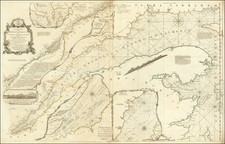
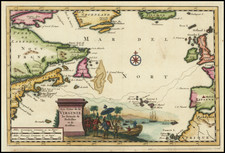
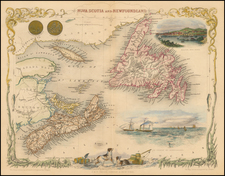
![[ Cape Cod to Acadia ] Pas-Kaart Vande Zee Kusten inde boght van Niew Engeland Tusschen de Staaten Hoek en C.de Sable . . .](https://storage.googleapis.com/raremaps/img/small/94453.jpg)
